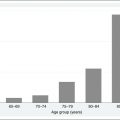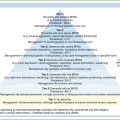Chapter 14 CLINICAL COGNITIVE ASSESSMENT
INTRODUCTION
Clinical cognitive assessment involves the informal and formal testing of memory and other intellectual abilities in the context of the overall clinical assessment of the older person. It needs to be undertaken with most, if not all, people being assessed by an older persons’ mental health service (OPMHS). Clinical cognitive assessment is not the same thing as formal neuropsychological testing, which should be undertaken by specialised personnel, preferably by clinical neuropsychologists. Most people being assessed by an OPMHS will not require formal neuropsychological testing. However, clinical cognitive assessment is a basic skill that all health workers within an OPMHS team should master.
CONTEXT OF COGNITIVE ASSESSMENT
Although clinical cognitive assessment can be undertaken by experienced mental health workers without the assistance of standardised rating scales, in most cases the worker will use standardised measures. The advantage of using such scales is that it is easier to communicate the findings with other health workers and to make longitudinal comparisons by using the same scales each time. It is also easier to interpret scores in the light of normative data for potential confounders, like education and age, if one has used a standardised test.
In Chapter 13, the distinction between the MSE and the Mini-Mental State Examination (MMSE) (Folstein et al 1975) was emphasised. This needs to be borne in mind by inexperienced mental health workers.
COMPONENTS OF CLINICAL COGNITIVE TESTING
COMPONENTS OF MEMORY
The terminology for the various components of memory sometimes causes confusion. The ability to hold information in the mind for brief periods, either in the visuospatial sketchpad (imagine a jotting pad) or in the phonological loop (imagine a loop of audio tape), is now generally referred to as ‘working memory’. Working memory has been likened to RAM in a computer. Material in working memory disappears when conscious effort is turned off, just like material stored in RAM, which disappears when the power is turned off. Neuropsychologists previously referred to working memory as ‘short-term memory’. However, mental health workers often use the term ‘short-term memory’ to refer to ‘recent memory’ and the term ‘long-term memory’ to refer to ‘remote memory’.
SCREENING INSTRUMENTS
It is important that screening is distinguished from diagnosis. Screening is designed to identify a subgroup of older people in which further diagnostic work-up is required. OPMHS often use a standardised approach to clinical cognitive assessment. Many services use long-established screening instruments such as the MMSE (Folstein et al 1975), although, in the United States, the Department of Veterans Affairs has supported the development of the Saint Louis University Mental Status (SLUMS) examination to replace the MMSE (Tariq et al 2006). In the United Kingdom, the cognitive section (CAMCOG–R) of the revised Cambridge Mental Disorders of the Elderly Examination (CAMDEX–R) (Roth et al 1999) has been used for many years. More recently, the revised version of the Addenbrooke’s Cognitive Examination (ACE–R) (Mioshi et al 2006) has been adopted by some centres. The ACE–R includes the MMSE and executive function tests. In Canada, the Montreal Cognitive Assessment scale (MoCA) (Nasreddine et al 2005) has been developed to screen for mild cognitive impairment. In Australia, access to subsidised cholinesterase medication (donepezil, rivastigmine and galantamine) and to subsidised memantine under the Pharmaceutical Benefits Scheme (PBS) generally requires testing the person on the MMSE or on a more extended battery, the cognitive subscale of the Alzheimer’s Disease Assessment Scale (ADAS–Cog) (Mohs et al 1983).
MINI-MENTAL STATE EXAMINATION
When the Mini-Mental State Examination (MMSE) was first introduced in 1975, it represented a significant advance because it allowed doctors and other clinicians without formal training in neuropsychology to administer a brief screening test to identify people who might be suffering from dementia. Although the MMSE is in widespread use around the world, and has been translated into many languages, it has some major deficiencies that mean that it should not be used as the sole clinical cognitive assessment tool in OPMHS. It suffers from so-called ‘ceiling’ and ‘floor’ effects, and is difficult to administer via an interpreter. Ceiling effects mean that some people score maximally despite having obvious cognitive impairment, whereas floor effects mean that some people, particularly those living in residential aged care facilities (RACFs), score zero, making it difficult to track their progress with this instrument.
Because the MMSE is so commonly used, it is worthwhile considering its items in more detail here. However, it is worth emphasising that the individual MMSE items do not measure single cognitive domains. The MMSE begins with five items that test orientation to time and five items that test orientation to place. Following the original publication of the MMSE in 1975, there has developed considerable variation in the precise wording of these items and in the scoring approach used. The nature of the items testing orientation to place is such that people examined at home are likely to score higher than those examined in less familiar environments, such as hospitals and clinics. This variability reduces the generalisability of scores obtained in different environments. The next item involves the registration of three words for later recall. The original three words, ‘apple, table, penny’, have now been over-learned by some people, including some with dementia, such that they may no longer be a valid test of new learning ability. The Standardised MMSE (SMMSE) (Molloy et al 1991) contains different words as well as alternative sets of equivalent words to allow valid retesting.
When using the MMSE to monitor progress over time, it is important that a consistent method of administration is used and that consistent scoring rules are applied. For instance, one needs to decide whether the person will be scored as correct if they are only one or two days out in stating the date. The SMMSE and the ACE–R both have explicit scoring rules for the MMSE and for this reason might be preferred to the original MMSE by some teams. The other important issue is the use of alternative memory tasks. Although it is common practice for people to be given the same memory task (e.g. ‘apple, table, penny’) each time they are tested on the MMSE, this does not make good sense from a neuropsychological perspective unless the interval between testing occasions is at least 6 months, and preferably longer.
Stay updated, free articles. Join our Telegram channel

Full access? Get Clinical Tree





